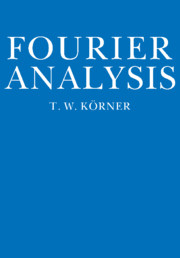Book contents
- Frontmatter
- Miscellaneous Frontmatter
- Contents
- PREFACE
- PART I FOURIER SERIES
- 1 Introduction
- 2 Proof of Fejér's theorem
- 3 Weyl's equidistribution theorem
- 4 The Weierstrass polynomial approximation theorem
- 5 A second proof of Weierstrass's theorem
- 6 Hausdorff's moment problem
- 7 The importance of linearity
- 8 Compass and tides
- 9 The simplest convergence theorem
- 10 The rate of convergence
- 11 A nowhere differentiable function
- 12 Reactions
- 13 Monte Carlo methods
- 14 Mathematical Brownian motion
- 15 Pointwise convergence
- 16 Behaviour at points of discontinuity I
- 17 Behaviour at points of discontinuity II
- 18 A Fourier series divergent at a point
- 19 Pointwise convergence, the answer
- PART II SOME DIFFERENTIAL EQUATIONS
- PART III ORTHOGONAL SERIES
- PART IV FOURIER TRANSFORMS
- Part V FURTHER DEVELOPMENTS
- PART VI OTHER DIRECTIONS
- Appendix A The circle T
- Appendix B Continuous function on closed bounded sets
- Appendix C Weakening hypotheses
- Appendix D Ode to a galvanometer
- Appendix E The principle of the argument
- Appendix F chase the constant
- Appendix G Are share prices in Brownian motion?
- Index
17 - Behaviour at points of discontinuity II
Published online by Cambridge University Press: 05 June 2014
- Frontmatter
- Miscellaneous Frontmatter
- Contents
- PREFACE
- PART I FOURIER SERIES
- 1 Introduction
- 2 Proof of Fejér's theorem
- 3 Weyl's equidistribution theorem
- 4 The Weierstrass polynomial approximation theorem
- 5 A second proof of Weierstrass's theorem
- 6 Hausdorff's moment problem
- 7 The importance of linearity
- 8 Compass and tides
- 9 The simplest convergence theorem
- 10 The rate of convergence
- 11 A nowhere differentiable function
- 12 Reactions
- 13 Monte Carlo methods
- 14 Mathematical Brownian motion
- 15 Pointwise convergence
- 16 Behaviour at points of discontinuity I
- 17 Behaviour at points of discontinuity II
- 18 A Fourier series divergent at a point
- 19 Pointwise convergence, the answer
- PART II SOME DIFFERENTIAL EQUATIONS
- PART III ORTHOGONAL SERIES
- PART IV FOURIER TRANSFORMS
- Part V FURTHER DEVELOPMENTS
- PART VI OTHER DIRECTIONS
- Appendix A The circle T
- Appendix B Continuous function on closed bounded sets
- Appendix C Weakening hypotheses
- Appendix D Ode to a galvanometer
- Appendix E The principle of the argument
- Appendix F chase the constant
- Appendix G Are share prices in Brownian motion?
- Index
Summary
We have seen in Chapter 8 how Kelvin invented machines which could compute periodic functions from their Fourier series and conversely obtain the Fourier series of a given periodic function. One such machine was constructed by Michelson to work to a higher accuracy and to involve many more terms than previous models. (Michelson's ability to build and operate equipment to new standards of accuracy was legendary. Of his interferometer which he invented and used in the Michelson Morley experiments it was said that it was a remarkable instrument – provided you had Michelson to operate it. His experiments to measure the diameter of the nearest stars using an interferometer were not reproduced for 30 years.)
Michelson tested his machine by feeding in the first 80 Fourier coefficients of the sawtooth function h defined in Chapter 16. To his surprise the machine did not produce an exact sawtooth but instead added two little blips on either side of the discontinuity as shown in Figure 17.1. Even after making every effort to remove any mechanical defects which could account for them, the blips still remained. Finally hand calculation confirmed the existence of blips in Sn(h,) close to the discontinuity. The effect of increasing n was to move the blips closer and closer to the discontinuity but they remained and their height (in absolute value) remained 17 or 18% above the correct absolute value. How could this be reconciled with Theorem 16.4 (or indeed Lemma 16.1)?
- Type
- Chapter
- Information
- Fourier Analysis , pp. 62 - 66Publisher: Cambridge University PressPrint publication year: 1988
- 2
- Cited by



